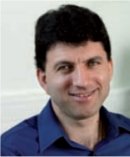Keynote Lecture
Computer Aided-Visual Perception : Challenges and Perspectives

Professor Nikos Paragios
Ecole Centrale de Paris / INRIA Saclay, Ile-de-France
France
E-mail: nikos.paragios@ecp.fr
Abstract: Computer aided human perception aims at developing
intelligent algorithms towards understanding visual cues coming from images,
video, or other means of gathering visual information. Such a process often
consists of three stages, initially the problem of perception is
parameterized through a mathematical model where the estimation of its
parameters will lead to visual understanding. Then, the model is associated
with the available observations through the definition of an objective
function and last, this function is optimized using computational methods.
The main challenges that one has to address in this context is the curses of
dimensionality, non-linearity, non-convexity and modularity. In simple
words, even the simplest possible perception problem could involve too many
parameters where the association between the data and them is not
straightforward and is done through non-convex functions. In this talk, we
will present a generic mathematical framework that exploits recent advances
in discrete optimization to address computational visual perception.
Numerous image processing, computer-aided diagnosis and computer vision
applications will be considered to demonstrate the potentials of this
method.
Brief Biography of the Speaker:
Nikos Paragios (http://vision.mas.ecp.fr)
obtained his B.Sc. (highest honors, valedictorian) and M.Sc. (highest
honors) in Computer Science from the University of Crete (Greece)
[1994,1996] , his Ph.D. in electrical and computer engineering from
I.N.R.I.A. [2000] and his D.Sc. (Habilitation a Diriger de Recherches) from
the University of Nice/Sophia Antipolis (France) [2005)]. He is professor of
applied mathematics at the Ecole Centrale de Paris - one of most exclusive
engineering schools "Grande Ecoles" - leading the Medical Imaging and
Computer Vision Group. He is also affiliated with INRIA Saclay Ile-de-France,
the French Research Institute in Informatics and Control heading the GALEN
group. Prior to that he was professor/(2004-2005) at the Ecole Nationale de
Ponts et Chaussees, affiliated with Siemens Corporate Research (Princeton,
NJ, 1999-2004) as a project manager, senior research scientist and research
scientist. In 2002 he was an adjunct professor at Rutgers University and in
2004 at New York University. N. Paragios was a visiting professor at Yale
University in 2007.
Professor Paragios has co-edited four books, published more than hundred
papers (DBLP server) in the most prestigious journals and conferences of
medical imaging and computer vision, gave more that hundred invited
lectures, and has twelve US issued patents and more than twenty pending. His
work has approx 3,500 citations in googlescholar and approx 2,000 in scopus,
and and his H-number according to scholar is 28 and 24 according to scopus.
He is a Senior member of IEEE, associate editor for the IEEE Transactions on
Pattern Analysis and Machine Intelligence (PAMI), area editor for the
Computer Vision and Image Understanding Journal (CVIU) and member of the
Editorial Board of the International Journal of Computer Vision (IJCV), the
Medical Image Analysis Journal (MedIA) and the Journal of Mathematical
Imaging and Vision (JMIV). Professor Paragios is one of the program chairs
of the 11th European Conference in Computer Vision (ECCV'10, Heraklion,
Crete). In 2008 N. Paragios was the laureate of one of Greece's highest
honor for young academics and scientists of nationality or descent
(world-wide), the Bodossaki Foundation Prize in the field of applied
sciences. In 2006, he was named one of the top 35 innovators in science and
technology under the age of 35 from the MIT's Technology Review magazine. He
and his collaborators were the recipients of numerous scientific rewards,
like for example the Francois Erbsmann prize for the IPMI'07 conference. His
research interests are in the areas of computer vision, medical image
analysis and human-computer interaction.